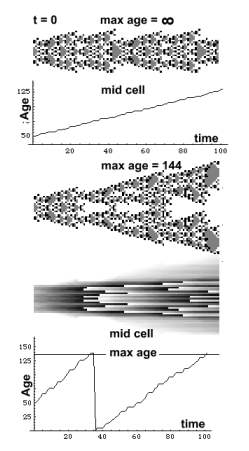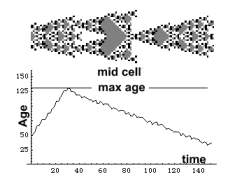 |
Differentiation
 |
Any interaction
which rescues the CA from its isolation, induces differentiation.
Perturbations like, somatic, and age injuries, are
differentiations. The outcome of a differentiation is unpredictable and
therefore creative. Over a longer time span differentiation may seem
predictable, like the transition from zygote to adult. Yet on the micro-scale
it is unpredictable and therefore
creative.
In the next experiment, cells start aging at the same velocity like the CA above. At t = 30, aging acceleration was negative. For a while the CA continues differentiating as above, while its condition (health) starts deteriorating. Shortly before dying it is rescued by a zygote which matures into an minimally differentiated CA, alas, the age of its cells is zero. This CA will never respond to max age lowering. It might be rescued form its 'unhealthy' state, by injuring its structure. You may regard it as a CA spore
 |
Setup
zygote -> effect[no, 1000]; go[63]; restoreparams;
age[[no]] += a[[no]];
If[no == 1, age[[no]] += (toamplify
a[[2]] ); toamplify = 2.5; effect[1, 144];
effect[1, 1144]; go[100]; restore params; toamplify = 2.5; If [ j==30,
toamplify = -2]; effect[1, 144]; effect[1, 1144];
Next page